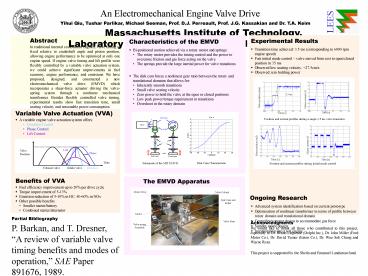Abstract - PowerPoint PPT Presentation
1 / 1
Title:
Abstract
Description:
If engine valve timing and lift profile were flexibly ... Smaller starter/battery. Combined starter/alternator. Valve spring Assembly. Motor. Motor Drive ... – PowerPoint PPT presentation
Number of Views:70
Avg rating:3.0/5.0
Title: Abstract
1
An Electromechanical Engine Valve Drive
LEES
Yihui Qiu, Tushar Parlikar, Michael Seeman, Prof.
D.J. Perreault, Prof. J.G. Kassakian and Dr. T.A.
Keim Massachusetts Institute of Technology,
Laboratory for Electromagnetic and Electronic
Systems
Abstract In traditional internal combustion
engines, valve timing is fixed relative to
crankshaft angle and piston position, allowing
engine performance to be optimized at only one
engine speed. If engine valve timing and lift
profile were flexibly controlled by a variable
valve actuation system, we could achieve
significant improvements in fuel economy, engine
performance, and emissions. We have proposed,
designed, and constructed a new electromechanical
valve drive (EMVD) which incorporates a
shear-force actuator driving the valve-spring
system through a nonlinear mechanical
transformer. Besides flexibly controlled valve
timing, experimental results show fast transition
time, small seating velocity and reasonable power
consumption.
- Characteristics of the EMVD
- Bi-positional motion achieved via a rotary motor
and springs - The rotary motor provides the timing control and
the power to overcome friction and gas force
acting on the valve - The springs provide the large inertial power for
valve transitions - The disk cam forces a nonlinear gear ratio
between the rotary and translational domains that
allows for - Inherently smooth transitions
- Small valve seating velocity
- Zero power to hold the valve at the open or
closed positions - Low peak power/torque requirement in transitions
- Overshoot in the rotary domain
- Experimental Results
- Transition time achieved 3.5 ms (corresponding
to 6000 rpm engine speed) - Fast initial mode control valve moved from rest
to open/closed position in 35 ms - Observed low seating velocity lt27.5cm/s
- Observed zero holding power
- Variable Valve Actuation (VVA)
- A variable engine valve actuation system offers
- Duration Control
- Phase Control
- Lift Control
- Benefits of VVA
- Fuel efficiency improvement up to 20 per drive
cycle - Torque improvement of 5-13
- Emission reduction of 5-10 in HC, 40-60 in NOx
- Other possible benefits
- Smaller starter/battery
- The EMVD Apparatus
Partial Bibliography P. Barkan, and T. Dresner,
A review of variable valve timing benefits and
modes of operation, SAE Paper 891676, 1989. J.
G. Kassakian, H-C. Wolf, J. M. Miller, and C. J.
Hurton, Automotive Electrical Systems Circa
2005, IEEE SPECTRUM, August 22-27, 1996. W. S.
Chang, T. A. Parlikar, J. G. Kassakian, and T.A.
Keim, An Electromechanical Valve Drive
Incorporating a Nonlinear Mechanical
Transformer, SAE Paper 2003-01-0036, 2003.
Acknowledgments We would like to thank all those
who contributed to this project, especially to
Dr. Bruno Lequesne (Delphi Inc.), Dr. John Miller
(Ford Motor Co.), Dr. David Turner (Eaton Co.),
Dr. Woo Sok Chang and Wayne Ryan. This project
is supported by the Sheila and Emanuel Landsman
fund.































